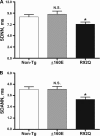Abnormal heart rate regulation in murine hearts with familial hypertrophic cardiomyopathy-related cardiac troponin T mutations
- PMID: 21131475
- PMCID: PMC3044052
- DOI: 10.1152/ajpheart.00247.2010
Abnormal heart rate regulation in murine hearts with familial hypertrophic cardiomyopathy-related cardiac troponin T mutations
Abstract
Mutations in cardiac troponin T (cTnT), Δ160E and R92Q, have been linked to familial hypertrophic cardiomyopathy (FHC), and some studies have indicated that these mutations can lead to a high incidence of sudden cardiac death in the relative absence of significant ventricular hypertrophy. Alterations in autonomic function have been documented in patients with hypertrophic cardiomyopathy. We hypothesize that alterations in autonomic function may contribute to mutation-specific clinical phenotypes in cTnT-related FHC. Heart rate (HR) variability (HRV) has been used to assess autonomic function from an electrocardiograph. Nontransgenic, Δ160E, or R92Q mice were implanted with radiofrequency transmitters to obtain continuous electrocardiograph recordings during 24-h baseline and 30-min recordings after β-adrenergic receptor drug injections. Although Δ160E mice did not differ from nontransgenic mice for any 24-h HRV measurements, R92Q mice had impaired HR regulation, as measured by a decrease in the SD of the R-R interval, a decrease in the low frequency-to-high frequency ratio, a decrease in normalized low frequency, and an increase in normalized high frequency. β-Adrenergic receptor density measurements and HRV analysis after drug injections did not reveal any significant differences for Δ160E or R92Q mice versus nontransgenic mice. Arrhythmia analysis revealed both an increased incidence of heart block in R92Q mice at baseline and frequency of premature ventricular contractions after isoproterenol injections in Δ160E and R92Q mice. In addition, Δ160E and R92Q mice exhibited a prolonged P duration after drug injections. Therefore, between two independent and clinically severe cTnT mutations within the same functional domain, only R92Q mice exhibited altered autonomic function, whereas both mutations demonstrated abnormalities in conduction and ventricular ectopy.
Figures






Similar articles
-
Independent FHC-related cardiac troponin T mutations exhibit specific alterations in myocellular contractility and calcium kinetics.J Mol Cell Cardiol. 2007 Jun;42(6):1098-110. doi: 10.1016/j.yjmcc.2007.03.906. Epub 2007 Mar 31. J Mol Cell Cardiol. 2007. PMID: 17490679
-
Cardiac troponin T mutations: correlation between the type of mutation and the nature of myofilament dysfunction in transgenic mice.J Physiol. 2001 Oct 15;536(Pt 2):583-92. doi: 10.1111/j.1469-7793.2001.0583c.xd. J Physiol. 2001. PMID: 11600691 Free PMC article.
-
Hypertrophy, fibrosis, and sudden cardiac death in response to pathological stimuli in mice with mutations in cardiac troponin T.Circulation. 2004 Oct 12;110(15):2102-9. doi: 10.1161/01.CIR.0000144460.84795.E3. Epub 2004 Oct 4. Circulation. 2004. PMID: 15466629
-
Molecular mechanisms of cardiac myofilament activation: modulation by pH and a troponin T mutant R92Q.Basic Res Cardiol. 2002;97 Suppl 1:I102-10. doi: 10.1007/s003950200038. Basic Res Cardiol. 2002. PMID: 12479243 Review.
-
Sarcomeric proteins and familial hypertrophic cardiomyopathy: linking mutations in structural proteins to complex cardiovascular phenotypes.Heart Fail Rev. 2005 Sep;10(3):237-48. doi: 10.1007/s10741-005-5253-5. Heart Fail Rev. 2005. PMID: 16416046 Review.
Cited by
-
Electrocardiographic Characterization of Cardiac Hypertrophy in Mice that Overexpress the ErbB2 Receptor Tyrosine Kinase.Comp Med. 2015 Aug;65(4):295-307. Comp Med. 2015. PMID: 26310459 Free PMC article.
-
Electrocardiographic features of children with Duchenne muscular dystrophy.Orphanet J Rare Dis. 2022 Aug 20;17(1):320. doi: 10.1186/s13023-022-02473-9. Orphanet J Rare Dis. 2022. PMID: 35987773 Free PMC article. Review.
-
Cardiac-specific over-expression of epidermal growth factor receptor 2 (ErbB2) induces pro-survival pathways and hypertrophic cardiomyopathy in mice.PLoS One. 2012;7(8):e42805. doi: 10.1371/journal.pone.0042805. Epub 2012 Aug 9. PLoS One. 2012. PMID: 22912742 Free PMC article.
-
Long term ablation of protein kinase A (PKA)-mediated cardiac troponin I phosphorylation leads to excitation-contraction uncoupling and diastolic dysfunction in a knock-in mouse model of hypertrophic cardiomyopathy.J Biol Chem. 2014 Aug 15;289(33):23097-23111. doi: 10.1074/jbc.M114.561472. Epub 2014 Jun 27. J Biol Chem. 2014. PMID: 24973218 Free PMC article.
-
FRET-based analysis of the cardiac troponin T linker region reveals the structural basis of the hypertrophic cardiomyopathy-causing Δ160E mutation.J Biol Chem. 2019 Oct 4;294(40):14634-14647. doi: 10.1074/jbc.RA118.005098. Epub 2019 Aug 6. J Biol Chem. 2019. PMID: 31387947 Free PMC article.
References
-
- Chandra M, Rundell VL, Tardiff JC, Leinwand LA, De Tombe PP, Solaro RJ. Ca2+ activation of myofilaments from transgenic mouse hearts expressing R92Q mutant cardiac troponin T. Am J Physiol Heart Circ Physiol 280: H705–H713, 2001 - PubMed
-
- Chandra M, Tschirgi ML, Tardiff JC. Increase in tension-dependent ATP consumption induced by cardiac troponin T mutation. Am J Physiol Heart Circ Physiol 289: H2112–H2119, 2005 - PubMed
-
- Counihan PJ, Frenneaux MP, Webb DJ, McKenna WJ. Abnormal vascular responses to supine exercise in hypertrophic cardiomyopathy. Circulation 84: 686–696, 1991 - PubMed
Publication types
MeSH terms
Substances
Grants and funding
LinkOut - more resources
Full Text Sources
Molecular Biology Databases
Research Materials

